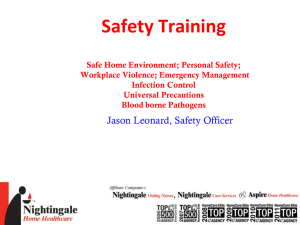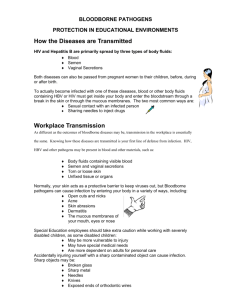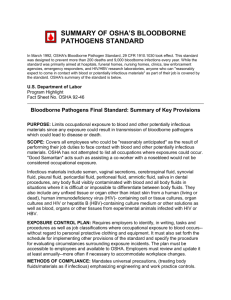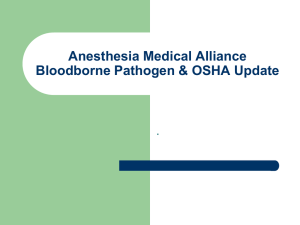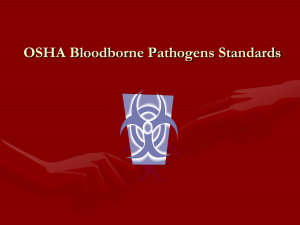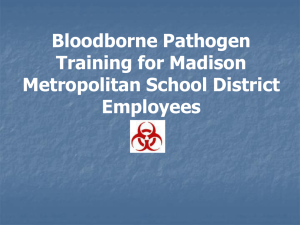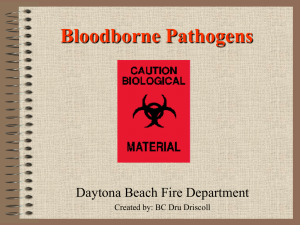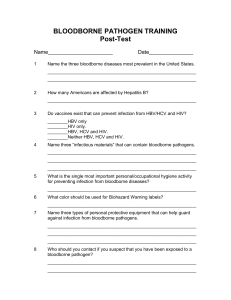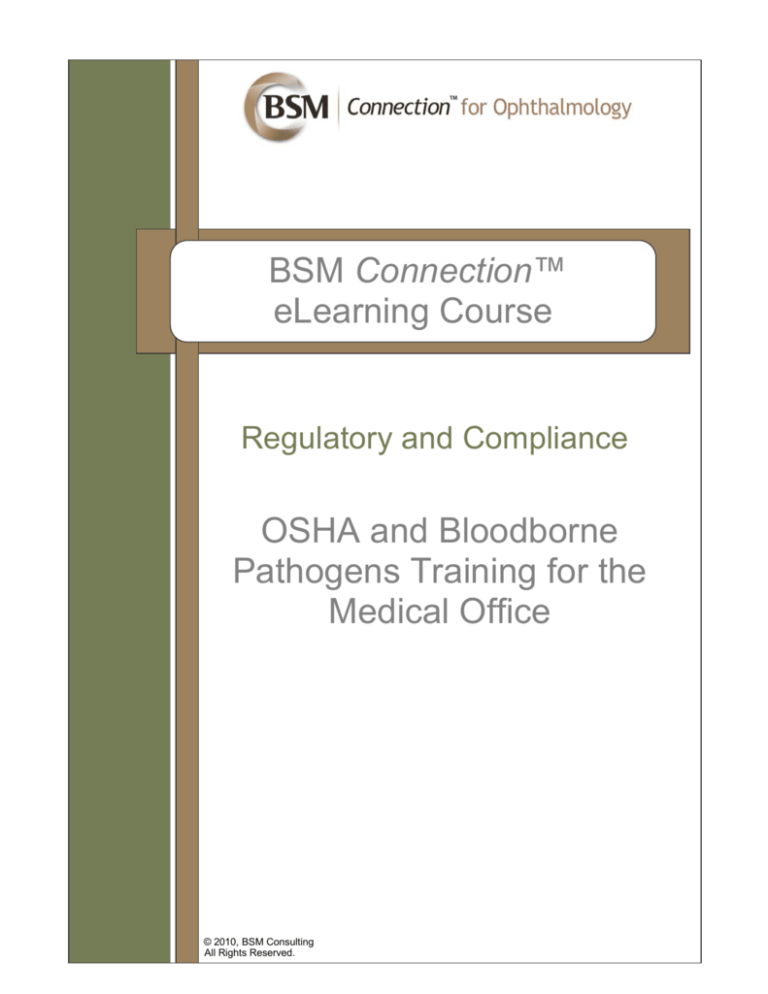
BSM Connection™
eLearning Course
Regulatory and Compliance
OSHA and Bloodborne
Pathogens Training for the
Medical Office
© 2010, BSM Consulting
All Rights Reserved.
OSHA and Bloodborne Pathogens Training
for the Medical Office
Regulatory and Compliance
Table of Contents
OVERVIEW ....................................................................................................................... 1
BLOODBORNE PATHOGENS ......................................................................................... 1
KEY INFORMATION – BLOODBORNE PATHOGENS .................................................... 1
EXPOSURE CONTROL PLAN ......................................................................................... 2
PROTECTIVE PROCEDURES (WORK PRACTICE CONTROLS) ................................... 2
MANAGEMENT OF BLOOD SPILLS AND CONTAMINATED SURFACES ..................... 4
MANAGEMENT OF REGULATED WASTE ...................................................................... 6
HEPATITIS B VACCINATION PROTOCOLS ................................................................... 7
EXPOSURE INCIDENT: REPORTING AND EVALUATION ............................................. 7
RECORD KEEPING .......................................................................................................... 8
CONCLUSION ................................................................................................................ 10
APPENDIX
OSHA Glossary: Bloodborne Pathogens.............................................................. 12
COURSE EXAMINATION ............................................................................................... 14
© 2010, BSM Consulting
OSHA and Bloodborne Pathogens Training
for the Medical Office
Regulatory and Compliance
OVERVIEW
In 1971, the federal government of the United States created the Occupational Safety & Health
Administration (OSHA) to prevent work-related injuries, illnesses, and deaths. The agency establishes
safety standards and can levy fines against non-compliant companies. OSHA has established such
standards for medical practices and facilities, and all healthcare businesses must comply with OSHA
standards regardless of the number of employees or the location.
Every employee must understand the guidelines set forth by OSHA. OSHA guidelines, standards, and
regulations cover an extremely wide sphere of topics and subject areas. The primary objective of this
particular course is to acquaint medical office employees with the Bloodborne Pathogens Standard and to
educate employees on the importance of compliance with this standard.
The educational information in this course is intended specifically for the employee working in a
medical office or clinic. Medical employees are required to participate in training, regardless of
their job descriptions. OSHA training is required at the time of hire, and retraining is mandatory
annually thereafter. In addition to the educational material provided by this course, consultation
with practice management regarding specific policies and procedures in the practice is essential.
BLOODBORNE PATHOGENS
The term bloodborne pathogen refers to any microorganism present in human blood that can cause
disease in humans. Bloodborne pathogens include, but are not limited to, hepatitis B virus (HBV) and
human immunodeficiency virus (HIV), the cause of AIDS. Healthcare workers with direct exposure to
blood and other potentially infectious material on the job risk contracting bloodborne infections from HBV,
HIV, and other pathogens. According to OSHA, approximately 8,700 healthcare workers each year are
infected with HBV, and 200 die annually from the infection.
OSHA requires all healthcare workers to be educated and informed of exposure risk while performing job
duties. Following the OSHA standards for protection and prevention greatly reduces risk for potential
exposure to bloodborne infections. Understanding the OSHA standard for bloodborne pathogens is
important to the protection of each employee. Any situation, question, or concern must be brought to the
attention of management immediately.
Are Tears Dangerous?
Tears are not considered infectious. While HIV has been found in tears, it is not
concentrated in an amount sufficient for transmission through tear fluid.
KEY INFORMATION – BLOODBORNE PATHOGENS
The following information will help healthcare personnel better understand bloodborne pathogens in the
workplace:
Routes of transmission – Bloodborne pathogens can enter the body via needlestick, cuts with
contaminated instruments or glass, or through abraded skin. They also can enter if a splash occurs on the
eyes, nose, or mouth.
Types of body fluid – Blood is the most risky fluid. Bloody body fluids are more risky than body fluids
without blood.
HIV-infected patients – The amount of circulating virus in patient blood is highest when the patient has
advanced AIDS and/or is experiencing acute anti-retroviral syndrome. Almost all seroconversions
(presence of HIV antibody in the blood) occur when the patient is symptomatic with a high viral load or
has advanced AIDS.
© 2010, BSM Consulting
1
OSHA and Bloodborne Pathogens Training
for the Medical Office
Regulatory and Compliance
EXPOSURE CONTROL PLAN
An exposure control plan (ECP) describes the rationale, policies, procedures, and interventions available
for employees who have potential for exposure to blood or other potentially infectious materials during the
normal course of work. Every practice or facility must maintain an ECP that includes the following
information:
1. Identification of various job titles/duties and exposure levels
(For example: Receptionist – Limited exposure to infectious materials and waste)
2. Engineering and work practice controls
a. Sharps containers and handling of sharps
b. Use of personal protective equipment
c. Housekeeping guidelines
3. Instructions for decontamination, transportation, and disposal of biohazardous material
4. Hepatitis B vaccination protocols
5. Exposure incident: reporting and evaluation
6. Evaluation of new, safer medical devices (sharps safety evaluation)
7. Hazard communication standards
8. OSHA/Bloodborne Pathogens Glossary
Examples of Employee Exposure Determination Located in the ECP
Job Title
Department
Task
Surgical Technician/
Surgical Assistant
Clinical
Exposure to infectious material and waste
Receptionist
Clerical
Little to no exposure to infectious material and
waste
Medical Assistant
Angiographer
Clinical
Exposure to infectious material and waste
Scribe/Assistant
Clinical/Clerical
Exposure to infectious material and waste
PROTECTIVE PROCEDURES (WORK PRACTICE CONTROLS)
To ensure the health and safety of all staff and patients, the medical practice provides and/or teaches
employees about work practice controls that will greatly eliminate the risk of exposure to bloodborne
pathogens while performing required job duties. The following procedures are required by the OSHA
standard and by all medical practices, regardless of size:
Handwashing
Frequent handwashing is the single most important defense in preventing the spread of infection. Each
employee is required to wash with hot, soapy water 1) after each patient contact; 2) after leaving the
clinical area and returning to the job; and 3) after using the restroom. Handwashing after removal of
gloves or other personal protective equipment is also required. For best results, wet hands with hot water,
apply soap, and rub together for at least 20 seconds. (This is equivalent to singing the song “Happy
Birthday” twice.) The medical office is required to:
© 2010, BSM Consulting
2
OSHA and Bloodborne Pathogens Training
for the Medical Office
Regulatory and Compliance
•
Provide handwashing sinks that are readily accessible to all employees –or–
•
Provide an antiseptic hand cleanser, antiseptic towelettes, or hand sanitizer. Note: Employees
should wash hands with soap and running water as soon as is reasonable when antiseptic hand
cleansers or towelettes are used.
Cleaning Medical Equipment
After each exam, it is essential that equipment in the exam room is cleaned and dried. Thoroughly wipe
with alcohol any surface that came in contact with the patient. Be sure the alcohol is completely dry prior
to reuse. At the end of the day and upon opening each morning, repeat this procedure. Many practices
clean the equipment in the presence of the patient.
When a patient has an infection, or if blood is visible on any surface, do not reuse equipment until it is
cleaned properly with an appropriate disinfectant solution, such as Cidex. Contact your manager for
assistance and follow the manufacturer’s guidelines to avoid damaging sensitive medical instruments and
to ensure that proper OSHA guidelines have been followed.
Proper Handling and Disposal of Needles and Sharps
Needles (and other contaminated sharps or scalpels) must not be bent, recapped, or removed from the
syringe unless the practice can demonstrate that no alternative is feasible or that such action is required
by a specific medical procedure. Remember:
•
Shearing or breaking of contaminated needles is prohibited.
•
Using needleless systems and self-sheathing needles to the extent possible is required by OSHA.
If bending, recapping, or needle removal is necessary, the use of a mechanical device or a one-handed
technique is required. Immediately after use, contaminated, reusable sharps (such as scissors, tweezers,
scalpels, etc.) shall be placed in appropriate containers until properly cleaned and sterilized. Reusable
sharps contaminated with blood or other potentially infectious materials may not be stored or processed
in a manner that requires employees to reach by hand into the container. When soaking sharp
instruments, place sharp end into the container with handle exposed for safe removal. Remember: Never
attempt to reach into a sharps container for any reason!
Disposable sharps containers must be:
Important Reminder
for All Medical Staff
•
Puncture resistant.
•
Labeled and color-coded (red) in accordance with this standard.
•
Leakproof on the sides and bottom.
•
Kept out of the reach of children or confused patients.
•
Closed when contents reach the fill line indicator on the container.
•
Closed immediately prior to removal or replacement to prevent
spillage or protrusion of contents during handling, storage, transport,
or shipping.
•
Disposed of properly. Containers may not be discarded in ordinary residential waste receptacles.
•
Labeled with the universal biohazard label (typically on the container) and dated.
© 2010, BSM Consulting
Eating, drinking,
smoking, and
applying cosmetics or
lip balm are
prohibited in work
areas where there is
a reasonable
likelihood of
occupational
exposure.
3
OSHA and Bloodborne Pathogens Training
for the Medical Office
Regulatory and Compliance
Storing Medications and Specimens
Food and medications may not be stored in the same cupboard or refrigerator. Specimens (such as
tissue for biopsy) must be placed in a leakproof container and labeled with name, date, and contents.
Utilizing and Wearing Personal Protective Equipment
Personal protective equipment (PPE) is provided to employees at no cost to the employee. The medical
office typically performs only minor procedures in the office. The most common PPE worn by the clinical
employee is gloves and a mask. Occasionally, eye protection and/or a lab coat may be worn. If splashing
is possible, wearing goggles or a face shield as additional PPE is recommended. Familiarize yourself with
the locations of required PPE in the clinic. PPE is considered “appropriate” only if it does not permit blood
or other potentially infectious materials to pass through it.
The concept of universal precautions is an approach to infection control and must be observed to
prevent contact with blood or other potentially infectious materials. According to universal precautions, all
human blood and certain human body fluids are treated as if known to be infectious for HIV, HBV, and
other bloodborne pathogens. Under circumstances in which differentiation is difficult or impossible, all
body fluids must be considered potentially infectious materials, and PPE should be used according to the
potential exposure risk.
Repairing and Replacing PPE
The practice is responsible for providing, repairing, or replacing PPE as needed to maintain its
effectiveness. Remove PPE if it becomes contaminated and before leaving the work area. Replace
gloves if torn, punctured, contaminated, or compromised in any way.
Applying and Wearing Gloves
If there is an expectation for contact with blood or other potentially infectious materials, such as mucous
membranes, non-intact skin, or when performing a procedure requiring infusion using a butterfly or an IV,
gloves are required. Wear gloves whenever handling or touching contaminated or potentially
contaminated items or surfaces.
•
Disposable (single-use) gloves must be replaced as soon as practical when contaminated, torn,
punctured, or when their ability to function as a barrier is compromised.
•
Never wash or attempt to decontaminate disposable (single-use) gloves for reuse.
•
Hypoallergenic gloves or other similar alternatives shall be readily accessible to those employees
who are allergic to the gloves normally provided.
•
Always remove soiled gloves by grasping the cuff and peeling the glove down (inside-out and over
the hand) in case there is any infectious material present on the glove. Avoid touching the outside
of the glove during removal.
•
Require that gloves be worn if the employee has cuts, scratches, or other breaks in the skin.
•
Place soiled PPE in an appropriately designated area or container for storage, washing,
decontamination, or disposal.
MANAGEMENT OF BLOOD SPILLS AND CONTAMINATED SURFACES
Each employee must become familiar with the policies and procedures for proper handling and removal
of any potentially hazardous material. When an incident occurs that involves a blood spill or
contaminated waste, employees must notify the supervisor.
© 2010, BSM Consulting
4
OSHA and Bloodborne Pathogens Training
for the Medical Office
Regulatory and Compliance
Work surfaces that become contaminated must be decontaminated with an approved disinfectant, such
as Cidex, after completion of all routine procedures and immediately after contamination or any spill of
blood or other potentially infectious materials. Work surfaces must be cleaned at the end of the work
shift. Broken glassware, which may be contaminated, must not be picked up directly with the hands. For
cleanup, use a mechanical means, such as a plastic broom, brush and dustpan, tongs, or forceps.
It is important to note that, due to potential risk, an employee who has not had the Hepatitis B
vaccination series should not handle a blood spill or potentially contaminated material. A manager or
supervisor should be contacted immediately for assistance.
Spill Kit
Each employee must know where the spill kit is located in the office. The practice may utilize a
commercially designed spill kit or one produced by the practice for cleaning up contaminated waste. See
the table below for instructions in making a non-commercial spill kit.
Tips on Making a Spill Kit for the Medical Office
Containers
Plastic container with sealable lid; five-gallon bucket or container (e.g.,
Rubbermaid container); (2) heavyweight five-ply trash bags; biohazard
labels; (2) red biohazard bags.
PPE
Two pairs of disposable gloves; mask, goggles or face shield; plastic
or rubber shoe covers; lab coat or apron; Playtex rubber gloves.
Absorbent Materials
Spill pads, absorbent pads, such as linen savers with plastic back;
paper towels for small spills.
Tools
Plastic dustpan; plastic broom or brush; tongs/ forceps for handling
broken glass.
Disinfectant/
Cleaning Solution
(Recommended by CDC)
Diluted household bleach can be used to wipe and clean most
equipment (check with manufacturer prior to use). EPA-approved
disinfectants (such as Cidex) are to be used for blood spills. Read the
label and carefully follow manufacturer’s directions.
Bleach dilution of 1:10 (1 part bleach to 10 parts water). Solution may
not be effective after bleach is diluted for 24 hours.
Note: Contact time for bleach is generally considered as the
time it takes the product to air dry.
The following steps will assist in cleaning up a blood spill or other contaminated waste:
Managing Blood Spills
Basic instructions for managing blood spills are as follows:
•
Put on gloves.
•
Remove any sharp objects with forceps or other mechanical device.
•
Saturate the spill with a 1:10 bleach solution.
•
Let stand 15-20 minutes.
•
Wipe up the spill with a paper towel.
•
Discard gloves and paper towels into a red biohazard bag.
© 2010, BSM Consulting
5
OSHA and Bloodborne Pathogens Training
for the Medical Office
Regulatory and Compliance
Red biohazard bags are indicated for non-sharps waste that is contaminated and distinguishable from
general waste. They must be two-ply thickness and labeled with a biohazard symbol. These are to be
disposed of in accord with local regulations regarding disposal of biohazardous materials.
MANAGEMENT OF REGULATED WASTE
An employee may be responsible for waste removal from the medical office. Therefore, all employees
must learn to recognize and understand how to differentiate residential waste from biohazardous waste.
The following table is designed as a tool to assist the employee with understanding the difference
between residential and biohazardous waste. Residential waste or municipal waste may be discarded in
the usual manner. Biohazardous waste contains blood or other potentially contaminated waste and must
be handled according to OSHA standards described throughout this program. If there is any question or
reason to suspect biohazardous waste, then the waste should be regarded as biohazardous and handled
accordingly.
A Guide for Assisting in Proper Identification of Medical Waste
Biohazardous Waste
(Use red biohazard bag for disposal)
Residential/Municipal Waste
Paper towel used to dry hands following glove
removal.
Paper towel used to absorb blood from countertop
prior to disinfecting surface.
Used disposable gloves worn assisting doctor
(no visible blood or other soiling).
Used disposable gloves worn by the surgeon during
a lesion removal with a significant amount of
visible blood.
Drape used to cover Mayo stand—no visible
contamination; no soiling occurred during
procedure.
Drape used to cover Mayo stand—contaminated
with blood from instruments and tissue samples.
Band-Aid or cotton ball used as pressure
dressing after IV removal–drop of blood.
Band-Aid or cotton ball or gauze saturated with
blood following a procedure.
Documentation of Proper Removal of Hazardous Waste
A licensed waste removal contractor is required to dispose of contaminated waste (biohazardous waste).
A receipt must be provided to verify that the waste was removed from the office. Receipts must be kept
on file to document proper waste disposal. After receiving a waste receipt, the employee must give it
promptly to management for recording. In the medical office, biohazardous waste (such as blood,
secretions, or tissue) must be placed inside a red biohazard bag, and then the red bag(s) and/or filled
sharps containers should be placed into a biohazardous waste box. Biohazardous waste boxes are
provided by the company that removes the box.
Important Information on Chemotherapeutic Agents
In the ophthalmic practice, chemotherapeutic agents are sometimes used and must be disposed of in a
yellow container or, if used infrequently, add a yellow chemotherapeutic waste label to a red waste
container.
Contaminated Sharps: Discarding and Containment
Contaminated sharps must be discarded immediately (or as soon as is feasible) in sharps containers, as
described earlier in the section titled: “Proper Handling and Disposal of Needles and Sharps.” Never
place full sharps containers and red bags into residential or municipal trash containers.
© 2010, BSM Consulting
6
OSHA and Bloodborne Pathogens Training
for the Medical Office
Regulatory and Compliance
Communicating Hazards
Red bags or red containers with the biohazard symbol also may be used to provide a warning of
regulated waste contents. The biohazard symbol below is used to identify potentially infectious material.
Warning signs must be red or fluorescent orange or (predominantly so) with lettering and symbols in a
contrasting color.
Universal Biohazard
Warning Symbol
(All warning signs must
contain the name of the
infectious agent)
HEPATITIS B VACCINATION PROTOCOLS
For employees who have a risk to exposure, the best defense against HBV is vaccination. This
vaccination must be offered shortly after hire as indicated by the job responsibilities for the ophthalmic
employee. The employer is not required to provide the HBV vaccine to an employee who works in a job
where the employee is not at risk for exposure.
The vaccination for HBV is a series of three injections. The first dose is given followed by a second dose
one month later. The third dose is administered six months after the initial dose. More than 90% of those
vaccinated develop immunity to the HBV. The medical practice shall ensure that the healthcare
professional responsible for the employee’s HBV vaccination is provided a copy of the OSHA bloodborne
pathogen regulation.
The practice is not required to provide the HBV vaccination in the following situations:
•
An employee has previously received the complete HBV vaccination series.
•
Antibody testing has revealed that the employee is immune.
•
The vaccine is contraindicated for medical reasons.
The HBV vaccine is genetically engineered, non-replicative, and safe. More than 90% of those vaccinated
develop immunity to the HBV. If the employee initially declines Hepatitis B vaccination but later decides to
accept the vaccination while still covered under the standard, the medical practice must make the HBV
vaccination available at that time. Employees who decline to accept HBV vaccination offered by the
employer are required to sign a statement appropriately documenting the declination. If a routine booster
dose(s) of HBV vaccine is recommended by the U.S. Public Health Service at a future date, such booster
dose(s) shall be made available in accordance with OSHA guidelines.
EXPOSURE INCIDENT: REPORTING AND EVALUATION
Each employee must become familiar with the policies and procedures for proper handling and removal
of any potentially hazardous material. An employee is considered to be exposed if injured with a
contaminated needle, scalpel, or other sharp instrument or has direct exposure through a cut or break in
the skin. If a mucous membrane is penetrated with contaminated blood or body fluids on a potentially
infected person, this is considered an exposure incident. When an exposure occurs that involves a blood
spill or contaminated waste, employees must notify a supervisor immediately.
© 2010, BSM Consulting
7
OSHA and Bloodborne Pathogens Training
for the Medical Office
Regulatory and Compliance
Exposure Steps
Immediately take these steps following exposure:
1. Remove bloodborne pathogen.
2. Sharps exposure—wash thoroughly with soap and water.
3. Mucous membrane exposure—flush with copious amounts of water.
4. Report immediately to supervisor.
5. Report within one to two hours of exposure to the local emergency room or designated health
provider for post-exposure evaluation and treatment.
6. Follow treatment plan of health provider, which may include prophylactic medication.
Reporting
Each incident must be investigated thoroughly and the circumstances surrounding the incident reviewed
carefully. This investigation will include the reporting of information pertaining to engineering controls in
place at the time of the incident, determining compliance with policies and procedures; description of any
devices involved; determination of usage of proper PPE; location of the incident; type of procedure being
performed; and a review of the employee’s training.
Post-Exposure Evaluation
Reporting an exposure incident right away is vital. Immediate intervention can forestall the development
of HBV, HCV, or enable an affected employee to track potential HIV infection. Prompt reporting can help
avoid spreading bloodborne infections to others. All exposure incidents will be kept confidential, and
follow-up care and treatment, if required, will be maintained in the employee’s confidential medical file.
Below is a sample checklist:
Bloodborne Pathogens Post-Exposure Checklist
Date
Post-Exposure Follow-Up
Accident report (worker’s comp form)/Sharps Injury Report completed.
Consent to test the source individual identified and obtained.
Source individual tested for HCV, HBV, and HIV.
Exposed employee tested for HBV, HCV, and HIV, if indicated.
Exposed employee offered the HBV vaccination again, if initially declined.
Employee referred to healthcare provider and given:
o A copy of the accident report (worker’s comp form)/Sharps Injury Report
o Results of the source individual’s testing (if applicable)
Healthcare provider given the source individual’s test results.
Written opinion from healthcare provider received within 15 days of the evaluation.
Employee medical record is stored in a confidential location.
Circumstances of the exposure incident are reviewed to determine whether modifications
are needed to bloodborne pathogens policies and procedures.
RECORDKEEPING
OSHA requires accurate documentation of not only medical records, but also of training provided to
employees. The sections below describe recordkeeping required by OSHA.
© 2010, BSM Consulting
8
OSHA and Bloodborne Pathogens Training
for the Medical Office
Regulatory and Compliance
Medical Records
Medical records required by the OSHA standard shall be maintained in accordance with OSHA
requirements. Furthermore, they shall be maintained within the employee’s confidential medical record
that is kept with the employee’s supervisor or with human resources.
Training Records
Training records are completed for each employee upon the completion of this training course. These
documents are kept for a minimum of three years. The training records include:
•
Dates of training sessions
•
Contents or summary of training sessions
•
Names and qualifications of persons conducting the training
•
Names and job titles of all persons attending the training
Required Posting
The practice is required to post a notice annually that informs employees of any accidents that have
involved exposure risk. This Log of Work-Related Injuries or Illnesses is completed when an employee is
exposed to potential contamination due to a needlestick or other injury involving a sharp (such as a
scalpel). If an employee is cut or stuck with a clean sharp, no recording on the OSHA log is required.
An OSHA 300 log must be posted in a visible place from February 1 through April 30 each year. When an
employee has an exposure incident, the OSHA 301 (incident report form) shall be completed and
maintained by the employer.
REVIEW
The following is a review of several of the key takeaway tips contained in this course:
1. Always practice standard precautions—assume all blood, bloody body fluids, and tissue are
positive for bloodborne pathogens such as HIV, hepatitis B, and hepatitis C.
2. Obtain free hepatitis B vaccine and quantitative titer.
3. If exposure occurs, wash or flush area, report incident to immediate supervisor, and access
emergency room within one to two hours of exposure.
4. Remember the risk rule of three:
a. Hepatitis B: 30%
b. Hepatitis C: 3%
c. HIV: 0.3%
5. Use PPE according to protocols:
a. Wear gloves to decrease inoculum from sharps injury.
b. Wear gowns, face shields, and gloves to decrease extent of mucous membrane or
skin exposure.
6. Eliminate risky practices:
a. Do not recap needles.
b. Do not overfill sharps containers.
7. Do not attempt invasive skills without training and/or supervision.
8. Dispose of sharps and other contaminated waste in identifiable biohazardous containers.
© 2010, BSM Consulting
9
OSHA and Bloodborne Pathogens Training
for the Medical Office
Regulatory and Compliance
CONCLUSION
All employees must take necessary precautions while performing job duties to limit the risk of exposure to
bloodborne pathogens. The practice will provide proper training and safeguards, but it is up to each
employee to understand and embrace these safe practices while carrying out job responsibilities.
Employees must remember to report any hazard or potential risk to management immediately and to
follow established safety guidelines to protect both patients and employees.
OSHA’s website provides more in-depth information about bloodborne pathogens on the bloodborne
pathogen Web page at www.osha.gov/bloodbornepathogens. More information is available on the
needlestick Web pages at www.osha.gov/needlesticks. OSHA has many publications, standards,
technical assistance, and compliance tools to help you.
© 2010, BSM Consulting
10
OSHA and Bloodborne Pathogens Training
for the Medical Office
Regulatory and Compliance
APPENDIX
© 2010, BSM Consulting
11
OSHA and Bloodborne Pathogens Training
for the Medical Office
Regulatory and Compliance
OSHA GLOSSARY: BLOODBORNE PATHOGENS
TERM
NAME
DEFINITIONS
Bloodborne
Pathogen
A disease-causing microorganism present in human blood that includes, but is
not limited to: hepatitis B virus (HBV), hepatitis C virus (HCV), and the human
immunodeficiency virus (HIV).
Contaminated
The presence, or the reasonably anticipated presence, of blood or other
potentially infectious materials on an item or surface.
Contaminated
Sharp
Any object with blood, bloody body fluids, other body tissues, or other potentially
infectious materials that can penetrate the skin, including, but not limited to:
needles, scalpels, broken glass, broken capillary tubes, and broken plastic.
Disinfectant
A chemical agent that inactivates most recognized pathogenic microorganisms.
Engineering
Controls
Devices that isolate or remove the bloodborne pathogen hazard from the
workplace. They include sharps containers, self-sheathing needles, and safer
medical devices, such as sharps with engineered sharps-injury protection and
needleless systems.
Exposure
Incident
A specific event occurring during the performance of an employee’s duties
involving eye, mouth, other mucous membranes, non-intact skin, or parenteral
contact with blood or other potentially infectious tissue or material.
HBV
Hepatitis B virus.
HCV
Hepatitis C virus.
HIV
Human immunodeficiency virus.
Needleless
System
A procedural device that does not use needles for: 1) the collection of bodily
fluids or withdrawal of body fluids after initial venous or arterial access is
established; 2) the administration of medication or fluids; or 3) any other
procedure involving the potential for occupational exposure to bloodborne
pathogens due to percutaneous injuries from contaminated sharps.
Occupational
Exposure
Reasonably anticipated skin, eye, mucous membrane, or parenteral contact with
blood or other potentially infectious materials that occurs during the performance
of an employee’s duties.
OPIM
Other potentially infectious materials. Includes body fluids; any unfixed tissue or
organ from a human; cell tissue; organ cultures; HIV-, HBV-, and HCVcontaining culture medium or other solutions; blood, organs, or other tissues
from experimental animals infected with HIV, HBV, or HCV.
OSHA
Occupational Safety & Health Administration. OSHA’s mission is to prevent
work-related injuries, illnesses, and deaths. Since the agency was created in
1971, occupational deaths have been cut by 62%, and injuries have declined by
42%.
Parenteral
Piercing of mucous membranes or the skin barrier through such events as
needlesticks, cuts, and abrasions.
PPE
Personal protective equipment. Specialized clothing or equipment worn by an
employee for protection against a hazard. General work clothes (e.g., scrubs,
uniforms, pants, shirts, or blouses) not intended to function as protection against
a hazard are not considered personal protective equipment. PPE includes, but is
not limited to: gloves, mask, gown, apron or lab coat, shoe covers, goggles, face
shield, etc.
© 2010, BSM Consulting
12
OSHA and Bloodborne Pathogens Training
for the Medical Office
Regulatory and Compliance
Regulated
Waste
1) Liquid or semi-liquid blood or other potentially infectious material; 2) any
contaminated item that would release blood or other potentially infectious
material in a liquid or semi-liquid state if compressed; 3) any item that is caked
with dried blood or other potentially infectious material and is capable of
releasing these materials during handling; 4) a contaminated sharp; and 5)
pathological and microbiological waste containing blood or other potentially
infectious material.
Sharps With
Engineered
Sharps Injury
Protections
A non-needle sharp or a needle device used for withdrawing body fluids,
accessing a vein or artery, or administering medications or other fluids, with a
built-in safety feature or mechanism that effectively reduces the risk of an
exposure incident.
Standard
Universal
Precautions
The practice of taking necessary precautions with ALL patients, instruments, and
materials as though they are carriers of a bloodborne pathogen. This includes
avoiding contact with patients’ bodily fluids by wearing PPE, such as gloves,
goggles, and face shields.
Sterilize
The use of a physical or chemical procedure that destroys all microbial life,
including highly resistant bacterial endospores.
Sterilization
The multi-step process of destroying all microorganisms, including bacterial
endospores.
Work-Practice
Controls
Those procedures put in place to reduce the risk of exposure by modifying
behaviors. Workplace controls that reduce the risk of infection include
handwashing, sharps disposing, lab specimen packaging, laundry handling, and
contaminated material cleaning.
© 2010, BSM Consulting
13
OSHA and Bloodborne Pathogens Training
for the Medical Office
Regulatory and Compliance
COURSE EXAMINATION
1. OSHA stands for:
a.
b.
c.
d.
Occupational and Safe Health Administration.
Ophthalmic Standards for Healthcare Administration.
Ophthalmic Safety Has Advantages.
Occupational Safety and Health Administration.
2. Immunization is provided for employees with occupational exposure for what disease?
a.
b.
c.
d.
Hepatitis A.
Hepatitis B.
Hepatitis C.
Hepatitis D.
3. What is the single most important method to prevent the spread of infection?
a.
b.
c.
d.
Washing your hands.
Covering your cough.
Using a biohazard container for contaminated products.
Using disinfectants to clean surfaces.
4. What is PPE?
a.
b.
c.
d.
Policies, Procedures, Equipment.
Personal Protective Equipment.
Personal Provider Elements.
Protection Produced Elements.
5. A common household product that can be used to kill bloodborne pathogens is:
a.
b.
c.
d.
Ammonia.
Lysol.
Bleach.
White vinegar.
6. Which of the following should be disposed of in a red biohazardous bag?
a.
b.
c.
d.
Used gauze with a drop of blood following infusion.
Used gauze used with a visible drop of dried tears.
Used gauze saturated with blood.
Used gauze worn postop under eye shield.
7. Which of the following should be avoided where there is a likelihood of occupational exposure?
a.
b.
c.
d.
Eating.
Documenting in the medical record.
Touching a potentially infected patient.
Wearing canvas shoes.
8. The following color is used to identify biohazardous material:
a.
b.
c.
d.
Blue.
Yellow.
Red.
Black.
© 2010, BSM Consulting
14
OSHA and Bloodborne Pathogens Training
for the Medical Office
Regulatory and Compliance
9. When referring to a theory of universal precautions for infection control:
a. All blood and other potentially infectious materials are handled as if they were known to
be infectious.
b. All dressings are disposed of in a biohazardous bag, regardless of the amount of soiling.
c. All employees are immunized against hepatitis.
d. All patients with eye infections are asked to wear gloves.
10. Spill kits contain all but one of the following:
a.
b.
c.
d.
Blanket.
Absorbent pads or material.
Cleaning agents.
Biohazard bags.
11. An example of a contaminated sharp would be:
a.
b.
c.
d.
IV tubing.
A syringe with a needle.
Broken glass.
A used scalpel.
12. Which of the following is considered PPE?
a.
b.
c.
d.
Surgical shoes.
Surgical mask.
Surgical tape.
Surgical locker.
13. If there is uncertainty as to how to handle a blood spill, the most important action is to:
a.
b.
c.
d.
Notify 911.
Notify your manager.
Notify the front desk.
Notify OSHA.
14. The Bloodborne Pathogens Standard requires the practice to have written guidelines for the
employees’ protection and reference. These guidelines are referred to as:
a.
b.
c.
d.
Employee Handbook or Guide.
Policy and Procedure Manual (PPM).
Exposure Control Plan (ECP).
Emergency and Disaster Plan (EDP).
15. The Bloodborne Pathogens Standard is one of several standards established by the federal
government. The enforcement agency for compliance with the Bloodborne Pathogens Standard
is:
a.
b.
c.
d.
FEMA.
DEA.
CDC.
OSHA.
© 2010, BSM Consulting
15

